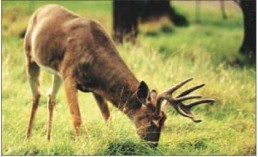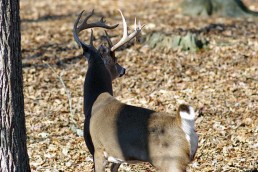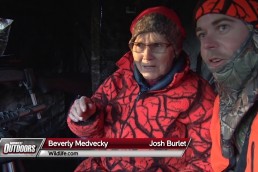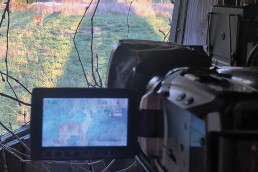Purposeful Scouting for Deer Season Success
SHARE THIS POST
Great hunters study their quarry all year. Often hunting season is only a few weeks, with months of talking and dreaming. Modern technology has allowed hunters to observe their quarry all year with the use of trail cameras. For the hunter who consistently takes game year after year, deer season is most of the year.
This hunter is a naturalist. A naturalist studies the habits and life cycle patterns of his quarry. It is the naturalist/hunter who takes his quarry and can guide others to similar success. The hunter who consistently takes big bucks year after year is the one who studies his quarry just as a naturalist would be inclined. He spends hours in the field, reads all he can find about the animals, and makes effective use of trail cameras to pattern his quarry.
Whitetail trails and patterns
In the case of whitetail deer, big bucks have different feeding patterns and travel different trails in summer and early fall than later in the year. In most cases, deer change their travel patterns the second week in October. Hunting pressure from an increase in human presence makes the deer react.
Later rut activity makes for more changes as they drive away rival bucks and seek out the does still in estrus.
The bucks maintain these habits until late winter when their feeding habits force them to change in concert with the change of diet from browse to grasses.
Sign found by the scouting hunter in spring is sign of most importance to the hunter in pursuit of a trophy buck, the dominant breeder buck, the guy with that big hat rack. Post season hunters are able to scout the deer’s home area and get a clear picture of where he will be in the fall when the hunting season returns.
Taking field notes is helpful. One can map the planned area of the hunt. You do not need to be an expert mapmaker. You just have to be able to find the same terrain in the fall. Mark wooded areas, swamps, sloughs, ridges, scrapes, rubs, bedding areas, feeding areas, water, doe trails, buck trails and where you sight game. The use of a GPS can help by using waypoints in the same manner.
Seeing the bigger picture
The notes and map present a picture of the hunting area and the game within it. By collecting and recording all the game sighted, one can plan other hunts than just deer hunts. Upland game can be the subject of hunts before deer hunting, and a coyote after the season concludes. The map becomes a plan for all hunting.
For those wanting a more accurate map, local highway departments often have maps for sale at a nominal price. They portray roads in the area, but the hunter still has to add some of the things mentioned above. Some things to add might include changes in terrain, such as small valleys with bluffs on each side that funnel deer activity. Creek crossings and fording areas often are full of sign, as animals are dependent upon water. Small ponds, stock tanks, and creeks become regular watering holes for wildlife.
A benefit of post season scouting is that signs found are from animals that have made it through the season and the winter. They should still be around the next fall.
Due to the lack of vegetation late in the season, the amount of sign is not as clear as is the case in late summer. Rubs are a bit hard to find, as they are aged and difficult to distinguish from old rubs of previous years. Scrapes are easy to spot. Both should be marked for future reference later in the fall to see if they are fresh.
Are you enjoying this post?
You can be among the first to get the latest info on where to go, what to use and how to use it!
Fresh rubs in an area with older ones tend to leave the impression that the deer making them has been around for a while. Deer return to old scrapes from one year to another. Once they begin to use them, they will return to refresh them every 12 to 48 hours.
Scrapes usually are located along field edges where there is a change from one type of vegetation to another. They are almost always beneath an overhanging branch and about four to five feet above the ground. In making the scrape, the buck leaves his scent on the tree by depositing his saliva as he licks or chews the branch.
If no suitable tree is available, deer make scrapes next to saplings and leave a rub on the tree itself.
Rubs serve two purposes. They aid in getting the velvet off of antlers during the early season. Later, they mark the buck’s territory. The territory is the buck’s breeding ground. The best prospect is an area with both old and new scrapes and rubs in large numbers. The chance of a big deer being there is good.
The usefulness of tracks
Deer tracks tell one of the presence of game. A single track of an animal wandering aimlessly through the woods is not one that needs recording. It is the track of a feeding animal and one probably not likely to use the trail again. Tracks of lots of deer indicate a major trail going to or from feeding and bedding areas. Such trails should be recorded and checked frequently for activity. Check the tracks for size.
If tracks are large mixed with small ones, then you are looking at a trail used by does and fawns. Check the area to the side of such trails for large tracks running in the same direction, but not on the trail. Bucks usually leave these tracks. Bucks like to stay near the does, but seek heavier cover.
Tracks will lead you to either feeding or bedding areas, which need to be marked on the map. Deer will move toward bedding areas in the morning and toward feeding areas in the evening. This tells you where to focus your hunting during those periods of the day.
Bucks make rubs along the trail on the side of the tree he is facing. This is another clue to which direction he is moving on a trail. Seldom does he use the same trail both coming and going to the feeding/bedding areas.
By setting up stands to use the appropriate trails at the time of day indicated by the sign, a hunter increases his chances of success. A properly marked map gives the hunter a picture of the deer’s activity all year.
Don Gasaway is a freelance outdoor writer from Marion, Ill. He is on Facebook at www.facebook.com/#1/DonGasawayWriter and www.facebook.com/DonsJournal. His blog is http://dongasaway.wordpress.com.
MWO
SHARE THIS POST
Did you enjoy this post?
You can be among the first to get the latest info on where to go, what to use and how to use it!
Don Gasaway
Don Gasaway is a veteran freelance outdoor writer from Marion, Ill. He may also be found at: https://www.facebook.com/DonGasawayWriter and facebook.com/Wandering Angler. Comments are welcome




